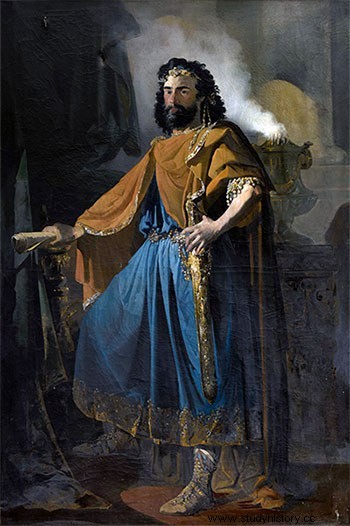Eurico (466-484) acceded to the throne of Tolosa after murdering his brother Theodoric II. From the Hispanic perspective, his reign is relevant for having promoted a considerable territorial expansion in the Iberian Peninsula and, likewise, the beginning of Visigothic settlements in it . The beginning of his reign coincided with the naval operation against the Vandals, planned by the new emperor Anthemius (467-482). The imperial reactivation, in case of victory, would have compromised the recently acquired positions in Narbonense and Provence, so Euric maintained an alert attitude and negotiations with the Swabians, with the Vandals themselves and even with Constantinople. The African enterprise having failed, the king had free hands to develop a great expansion of the lands subject to him to the north and south of the Pyrenees. In Gaul, Visigoth rule extended from the Loire to the Mediterranean, with the exception of Auvergne, tenaciously defended by the Gallo-Roman aristocracy . In the Iberian Peninsula, the objectives were focused on the Tarraconense and the containment of the Suebian kingdom in the northwest of the peninsula, limiting its southern overflow.

Visigothic Policy
The Visigothic policy regarding the Swabians was altered by the turn of Remismundo, who, in the same way as Agiulfo before him, moved away from his protectors, at the same time that he began an approach to Ravenna and to the Hispano-Roman aristocracy itself, disenchanted by the imperial ineffectiveness and prone to a modus vivendi with the barbarian settlers. A clear sign of this rapprochement was the occupation of Lisbon in 408, thanks to the favor of the upper classes of the city, although the control, yes, was ephemeral. Eurico reacted by promoting the accession of the areas already in the hands of the Visigoths and unleashing operations in the Lusitama, which would reduce or, at least, contain the Swabian expansionism. An example of the first type of policy is the priority attention dedicated to Mérida, whose defenses were strengthened and which was intended to be made visible through aristocratic immigration . The military interventions against the Swabians were not large-scale, but only limited to confining the town to the west of a hypothetical line that ran from the north of the middle Duero to the south of the lower Tagus. The effectiveness of this containment strategy is supported by the maintenance of this territorial division until the middle of the 6th century.
Occupation of the Tarraconense
The Hispanic province of Tarraconense, unlike the other dioceses, had maintained a more or less tenuous imperial presence. The final scene of the Roman political crisis, announced by the death of Ricimer and the disputed proclamation of Olibrio, both in 472, left that constituency totally defenseless and, therefore, easy prey to a power that had expanded to the other side of the Pyrenees to include all of Provence. In that year and the next, 473, a double Visigothic column penetrated the Roman province through the central-eastern Pyrenees and along the coast, occupying the interior of the Ebro valley and also the coastal cities. There was some resistance from sectors of the Hispano-Roman aristocracy, but also support, such as that of the dux Vicente, the only military officer left on the Peninsula.
Code of Eurico
The intention of territorially expanding the regnum tolosanum It was accompanied by outlines of a policy of internal cohesion, which would continue, accentuating, in the following reign and beyond 507. The codification undertaken by the monarch, the so-called Code of Eurico, although it has traditionally been considered as a legislation that attended as much only to the Visigoths, and not as a territorial corpus applicable to both communities, could have a very different meaning of legal recognition of the rapid transformations of all kinds that had taken place since 418 and had fostered an interethnic agglutination, thus encompassing, therefore, , said code to the set of Goths and Romans.
